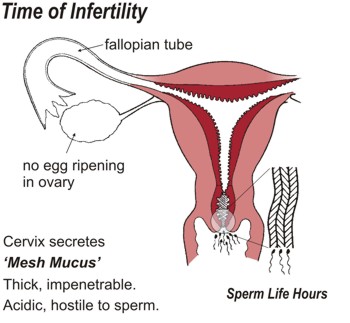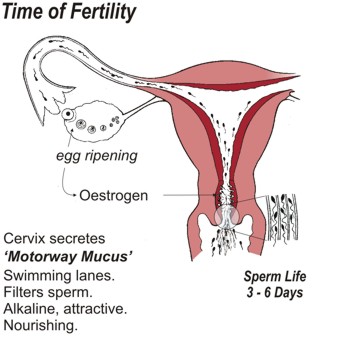understanding your fertility, page 4 of 14

The Role of the Cervix
To understand the important role of the cervix, we need to see the womb in cross section.
When there is no egg ripening in the ovary, the doorway to the womb (cervical os) is pinched shut to keep sperm out.
In addition, the passage through the cervix (cervical canal) is blocked by a white sticky mucus, produced from glands inside the cervix. This mucus is highly acidic and has a mesh structure, like a fishing net, to trap and destroy sperm. In these conditions, sperm cannot enter the cervix and their life expectancy in the vagina will be minutes, rather than hours.
when this mucus is present, pregnancy cannot occur

This illustration shows how everything changes once an egg is selected in the ovary. As the egg follicle ripens, it produces a hormone oestrogen which is the signal for the cervix to open.
The oestrogen also stimulates the glands in the cervix to disperse the mesh mucus and produce instead a wet slippery mucus with swimming lanes along which sperm can move easily, as if on a “motorway”. This new mucus is alkaline and contains glucose and other nutrients vital to sperm survival. It appears for approx. 6 days before ovulation and then dries up quickly. In this mucus, sperm can swim up into the cervix and survive for 3-6 days.
pregnancy can only occur when this mucus is present
In Summary
- The “mesh” mucus blocks the passage of sperm, preventing pregnancy from occurring.
- The “motorway” mucus prolongs the life of sperm and enables them to swim through the cervix and womb and into the fallopian tubes, in search of the egg.
- If couples learn to recognise these mucus changes, they can use the information to plan, space and limit their family size simply by observation and the appropriate timing of intercourse.
- Previous |
- Next |
- Exit Tutorial |
- Help |
- Download as a PDF
© 2011 Fertility Education & Training